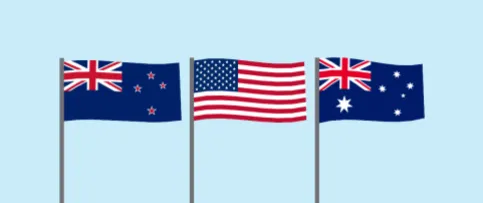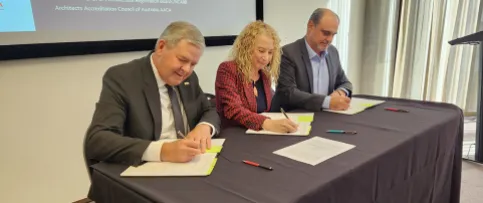Washington, DC—The National Council of Architectural Registration Boards (NCARB) and the Canadian Architectural Licensing Authorities (CALA) have signed a new Mutual Recognition Agreement (MRA) for reciprocal registration of architects between the two countries, which will go into effect 1 January 2014.
“The new agreement respects each country’s rigorous path to licensure, and serves as a bold model for mutual recognition agreements in the future,” said 2013-2014 NCARB President Blakely C. Dunn, AIA, NCARB. “It is a great success to be able to continue our long-standing recognition and exchange of professional credentials with Canada.”
In order for U.S. or Canadian architects to take advantage of this opportunity, their principle place of practice and the jurisdiction they are seeking licensure in must have signed the agreement. As of December 19, the new MRA has been signed by 31 U.S. jurisdictions and all 11 Canadian provinces. NCARB expects additional U.S. jurisdictions to sign the agreement in early 2014.
Architects in jurisdictions participating in the new agreement must have a valid license to practice architecture in their home country, plus 2,000 hours (approximately one year) of post-licensure experience. This agreement is only available to citizens or permanent residents of the United States or Canada. Architects in the United States and Canada will use the NCARB Certificate to send their information between jurisdictions. The architect must comply with all practice requirements of the jurisdiction and is subject to all governing legislation and regulations of the jurisdictions. Click here to read the full agreement.
A Long-Standing and Valued Relationship
The previous inter-recognition agreement between NCARB and the Canadian provincial associations was signed in 1994. It allowed for the immediate and mutual recognition of architects seeking reciprocal licensure in jurisdictions across our shared border. This agreement has served the two countries well and has been used as a model for mutual recognition agreements around the world.
The past 10 years of data suggests that over 300 Canadians have taken advantage of the current agreement and gained licensure in a U.S. jurisdiction. Conversely, almost 900 Americans have become licensed in a Canadian jurisdiction.
The recent evolution of U.S. and Canadian internship and examination requirements for licensure necessitated a review of the existing agreement. After over a year of exploration and negotiation between NCARB and CALA, a new agreement was presented and approved by NCARB’s Member Boards at its 2013 Annual Meeting in San Diego in June.
#####
About NCARB
The National Council of Architectural Registration Boards’ membership is made up of the architectural registration boards of all 50 states as well as those of the District of Columbia, Puerto Rico, Guam, and the U.S. Virgin Islands. NCARB assists its member registration boards in carrying out their duties and provides a certification program for individual architects.
NCARB protects the public health, safety, and welfare by leading the regulation of the practice of architecture through the development and application of standards for licensure and credentialing of architects. In order to achieve these goals, the Council develops and recommends standards to be required of an applicant for architectural registration; develops and recommends standards regulating the practice of architecture; provides to Member Boards a process for certifying the qualifications of an architect for registration; and represents the interests of Member Boards before public and private agencies. NCARB has established reciprocal registration for architects in the United States and Canada.
Visit: www.ncarb.org
Twitter: www.twitter.com/ncarb
Facebook: www.facebook.com/NCARB
YouTube: www.youtube.com/NCARBorg





